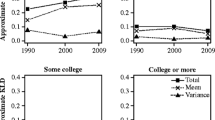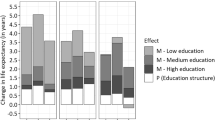Abstract
Previous studies have found that educational differences in mortality are weaker among the elderly. In this study I examine whether either cohort or period effects may have influenced the interpretation of age effects. Six 10-year birth cohorts are followed over 30 years through decennial censuses. Differential survival is inferred from changes in the relative proportions of a cohort in each education category as the cohort ages. In cross-section, younger persons generally show stronger education effects on survival, although this pattern is clearer for women than for men. There is evidence of period effects. Within cohorts, relative survival tends to increase with age.
Similar content being viewed by others
References
Anderson, M.J. and S.E. Fienberg. 1999. Who Counts? The Politics of Census Taking in Contemporary America. New York: Russell Sage Foundation.
Antonovsky, A. 1967. “Social Class, Life Expectancy and Overall Mortality.” Milbank Memorial Fund Quarterly 45:37–73.
Beckett, M. 2000. “Converging Health Inequalities in Later Life: An Artifact of Mortality Selection?” Journal of Health and Social Behavior 41:106–19.
Blustein, J. and L.J. Weiss. 1998. “Visits to Specialists Under Medicare: Socioeconomic Advantage and Access to Care.” Journal of Health Care for the Poor and Underserved 9:153–69.
Cassel, J., S. Heyden, A.G. Bartel, B.H. Kaplan, H.A. Tyroler, J.C. Cornoni, and C.G. Hames. 1971. “Incidence of Coronary Heart Disease by Ethnic Group, Social Class, and Sex.” Archives of Internal Medicine 128:901–906.
Centers for Disease Control and Prevention. 1999. “Achievements in Public Health, 1900–1999: Decline in Deaths From Heart Disease and Stroke—United States, 1900–1999.” Morbidity and Mortality Weekly Reports 48:649–56.
Cohen, B.B. 1987. Plan and Operation of the NHANES I Epide-miologic Followup Study, 1982–84. Washington, DC: National Center for Health Statistics.
Crystal, S. and D. Shea. 1990. “Cumulative Advantage, Cumulative Disadvantage, and Inequality Among Elderly People.” The Gerontologist 30:437–43.
Crystal, S., D. Shea, and S. Krishnaswami. 1992. “Educational Attainment, Occupational History, and Stratification: Determinants of Later-Life Economic Outcomes.” Journal of Gerontology 47:S213–21.
Davis S.K., M.A. Winkleby, and J.W. Farquhar. 1995. “Increasing Disparity in Knowledge of Cardiovascular Disease Risk Factors and Risk-Reduction Strategies by Socioeconomic Status: Implications for Policymakers.” American Journal of Preventive Medicine 11:318–23.
“Effects of Treatment on Morbidity in Hypertension. I. Results in Patients With Diastolic Blood Pressures Averaging 115 Through 129 mm Hg.” 1967. Journal of the American Medical Association 202:1028–34.
“Effects of Treatment on Morbidity in Hypertension. II. Results in Patients With Diastolic Blood Pressure Averaging 90 Through 114 mm Hg.” 1970. Journal of the American Medical Association 213:1143–52.
Elo, I.T. and S.H. Preston. 1996. “Educational Differentials in Mortality: United States, 1979–1985.” Social Science and Medicine 42:47–57.
Feldman, J.J., D.M. Makuc, J.C. Kleinman, and J. Cornoni-Huntley. 1989. “National Trends in Educational Differentials in Mortality.” American Journal of Epidemiology 129:919–33.
Fernandez, E.W. 1995. “Estimation of the Annual Emigration of U.S. Born Persons by Using Foreign Censuses and Selected Administrative Data: Circa 1980.” Working Paper 10, Population Division, U.S. Bureau of the Census.
Garrison, R.J., R.S. Gold, P.W. Wilson, and W.B. Kannel. 1993. “Educational Attainment and Coronary Heart Disease: The Framingham Offspring Study.” Preventive Medicine 22:54–64.
Green, G.E., R.S. Paul, E. Walsh, and D.A. Tice. 1968. “Coronary Artery Bypass Grafting.” Surgical Forum 19:159–61.
Gruentzig, A., R. Myler, R. Hanna, and M. Turina. 1977. “Coronary Transluminal Angioplasty.” Circulation 56:84.
Hill, M.E. 1999. “Multivariate Survivorship Analysis Using Two Cross-Sectional Samples.” Demography 36:497–503.
House, J.S., R.C. Kessler, A.R. Herzog, R.P. Mero, A.M. Kinney, and M.J. Breslow. 1990. “Age, Socioeconomic Status and Health.” Milbank Quarterly 68:383–411.
—. 1992. “Social Stratification, Age and Health.” Pp. 1–32 in Aging, Health Behaviors, and Health Outcomes, edited by K.W. Schaie, D. Blazer, and J.S. House. Hillsdale, NJ: Erlbaum.
House, J.S., J.M. Lepkowski, A.M. Kinney, R.P. Mero, R.C. Kessler, and A.R. Herzog. 1994. “The Social Stratification of Aging and Health.” Journal of Health and Social Behavior 35:213–34.
Kaplan, G.A. and J.E. Keil. 1993. “Socioeconomic Factors and Cardiovascular Disease: A Review of the Literature.” Circulation 88:1973–98.
Kawachi, I., S. Marshall, and N. Pearce. 1991. “Social Class Inequalities in the Decline of Coronary Heart Disease Among New Zealand Men, 1975–1977 to 1985–1987.” International Journal of Epidemiology 20:393–98.
Kestenbaum, B. 1986. “Mortality by Nativity.” Demography 23:87–90.
—. 1992. “A Description of the Extreme Aged Population Based on Improved Medicare Enrollment Data.” Demography 29:565–80.
Kitagawa, E.M. and P.M. Hauser. 1973. Differential Mortality in the United States: A Study in Socioeconomic Epidemiology. Cambridge, MA: Harvard University Press.
Kominski, R. and P.M. Siegel. 1993. “Measuring Education in the Current Population Survey.” Monthly Labor Review 116:34–38.
Kramarow, E., P. Pastor, and Y. Gorina. 2000. “Educational Differentials in Mortality Among Older U.S. Adults.” Presented at the annual meetings of the Population Association of America, March, Los Angeles.
Lang, T. and P. Ducimetière. 1995. “Premature Cardiovascular Mortality in France: Divergent Evolution Between Social Categories From 1970 to 1990.” International Journal of Epidemiology 24:331–39.
Liberatos, P., B.G. Link, and J.L. Kelsey. 1988. “The Measurement of Social Class in Epidemiology.” Epidemiologic Reviews 10:87–121.
“The Lipid Research Clinics Coronary Primary Prevention Trial Results. I. Reduction in Incidence of Coronary Heart Disease.” 1984a. Journal of the American Medical Association 251:351–64.
“The Lipid Research Clinics Coronary Primary Prevention Trial Results. II. The Relationship of Reduction in Incidence of Coronary Heart Disease to Cholesterol Lowering.” 1984b. Journal of the American Medical Association 251:365–74.
Marmot, M.G. and M.E. McDowall. 1986. “Mortality Decline and Widening Social Inequalities.” Lancet 2(8501):274–76.
Marshall, S.W., I. Kawachi, N. Pearce, and B. Borman. 1993. “Social Class Differences in Mortality From Diseases Amenable to Medical Intervention in New Zealand.” International Journal Epidemiology 22:255–61.
Matthews, K.A., S.F. Kelsey, E.N. Meilahn, L.H. Kuller, and R.R. Wing. 1989. “Educational Attainment and Behavioral and Biologic Risk Factors for Coronary Heart Disease in Middle-Aged Women.” American Journal of Epidemiology 29:1132–44.
McClellan, M. and H. Noguchi. 1998. “Technological Change in Heart-Disease Treatment: Does High Tech Mean Low Value?” American Economic Review 88:90–96.
National Center for Health Statistics. 2000. “National Health Interview Survey: Multiple Cause of Death Public Use Files, 1986–1994 Survey Years, Dates of Death 1986–1997.” Documentation.
O’Rand, A.M. 1996. “The Precious and the Precocious: Understanding Cumulative Disadvantage and Cumulative Advantage Over the Life Course.” The Gerontologist 36:230–38.
Parker, J., T. Gebretsadik, F. Sabogal, J. Newman, and H.W. Lawson. 1998. “Mammography Screening Among California Medicare Beneficiaries: 1993–1994.” American Journal of Preventive Medicine 15:198–205.
Pourat, N., T. Rice, G. Kominski, and R.E. Snyder. 2000. “Socioeconomic Differences in Medicare Supplemental Coverage.” Health Affairs 19:186–96.
Prentice, R.L. and R. Pyke. 1979. “Logistic Disease Incidence Models and Case-Control Studies.” Biometrika 66:403–11.
Preston, S.H. and I.T. Elo. 1995. “Are Educational Differentials in Adult Mortality Increasing in the United States?” Journal of Aging and Health 7:476–96.
Preston, S.H., I.T. Elo, A. Foster, and H. Fu. 1998. “Reconstructing the Size of the African American Population by Age and Sex, 1930–1990.” Demography 35:1–21.
Preston, S.H. and P. Taubman. 1994. “Socioeconomic Differences in Adult Mortality and Health Status.” Pp. 279–318 in Demography of Aging, edited by L.G. Martin and S.H. Preston. Washington, DC: National Academy Press.
Prewitt, K. 2000. “The US Decennial Census: Political Questions, Scientific Answers.” Population and Development Review 26:1–16.
Rogot, E., P.D. Sorlie, N.J. Johnson, and C. Schmitt. 1992. A Mortality Study of 1.3 Million Persons by Demographic, Social, and Economic Factors: 1979–1985 Followup. Washington, DC: U.S. Government Printing Office.
Rosenwaike, I. 1979. “A New Evaluation of United States Census Data on the Extreme Aged.” Demography 16:279–88.
Ross, C.E. and C.L. Wu. 1996. “Education, Age, and the Cumulative Advantage in Health.” Journal of Health and Social Behavior 37:104–20.
Ruggles, S. and M. Sobek. 1997. Integrated Public Use Microdata Series: Version 2.0. Minneapolis: Historical Census Projects, University of Minnesota.
Shea, S., A.D. Stein, C.E. Basch, R. Lantigua, C. Maylahn, D.S. Strogatz, and L. Novick. 1991. “Independent Associations of Educational Attainment and Ethnicity With Behavioral Risk Factors for Cardiovascular Disease.” American Journal of Epidemiology 134:567–82.
Sheifer S.E., S.S. Rathore, B.J. Gersh, K.P. Weinfurt, W.J. Oetgen, J.A. Breall, and K.A. Schulman. 2000. “Time to Presentation With Acute Myocardial Infarction in the Elderly: Associations With Race, Sex, and Socioeconomic Characteristics.” Circulation 102:1651–56.
Smith, T.W. 1993. “The Relationship of Age to Education Across Time.” Social Science Research 22:300–11.
Smith, J.P. and R.S. Kington. 1997. “Race, Socioeconomic Status, and Health in Later Life.” Pp. 106–62 in Racial and Ethnic Differences in the Health of Older Americans, edited by L.G. Martin and B.J. Soldo. Washington, DC: National Academy Press.
Sytkowski, P.A., R.B. D’Agostino, A. Belanger, and W.B. Kannel. 1996. “Sex and Time Trends in Cardiovascular Disease Incidence and Mortality: The Framingham Heart Study, 1950–1989.” American Journal of Epidemiology 143:338–50.
Tyack, D.B. 1974. The One Best System: A History of American Urban Education. Cambridge, MA: Harvard University Press.
U.S. Department of Health and Human Services. 1989. Reducing the Health Consequences of Smoking: 25 Years of Progress. Washington, DC: U.S. Department of Health and Human Services.
U.S. Department of Health, Education, and Welfare. 1964. Smoking and Health: Report of the Advisory Committee to the Surgeon General of the Public Health Service. Washington, DC: U.S. Department of Health and Human Services.
Wing, S., E. Barnett, M. Casper, and H.A. Tyroler. 1992. “Geographic and Socioeconomic Variation in the Onset of Decline of Coronary Heart Disease Mortality in White Women.” American Journal of Public Health 82:9204–209.
Wing, S., M. Casper, W. Riggan, C. Taylor, and H.A. Tyroler. 1988. “Socioenvironmental Characteristics Associated With the Onset of Decline of Ischemic Heart Disease Mortality in the United States.” American Journal of Public Health 78:923–26.
Wood, E., A.M. Sallar, M.T. Schechter, and R.S. Hogg. 1999. “Social Inequalities in Male Mortality Amenable to Medical Intervention in British Columbia.” Social Science and Medicine 48:1751–58.
Author information
Authors and Affiliations
Additional information
The author thanks Paul Rathouz for statistical advice, and Patrick Heuveline, Mary Elizabeth Hughes, Kathleen Cagney, Bert Kestenbaum, Vance Lauderdale III, Thomas D’Aunno, David Meltzer, Nicholas Christakis, Jack Iwashyna, and two anonymous reviewers for helpful suggestions. This work was supported in part by Grant R03 AG18491-01 from the National Institute on Aging. Demography, Volume 38-Number 4, November 2001
Rights and permissions
About this article
Cite this article
Lauderdale, D.S. Education and survival: Birth cohort, period, and age effects. Demography 38, 551–561 (2001). https://doi.org/10.1353/dem.2001.0035
Issue Date:
DOI: https://doi.org/10.1353/dem.2001.0035




